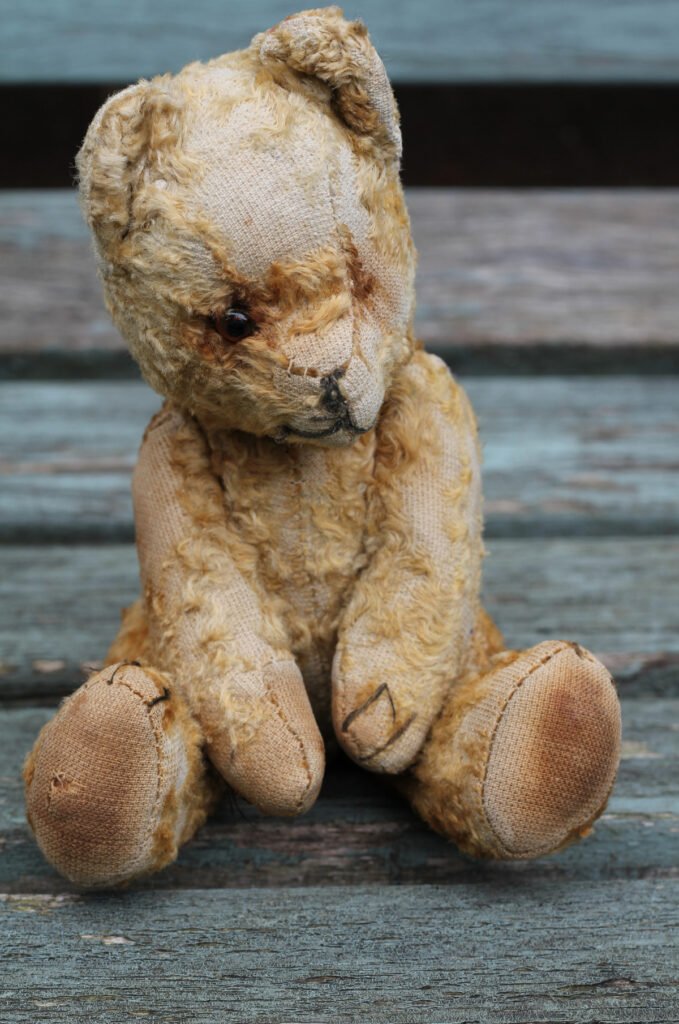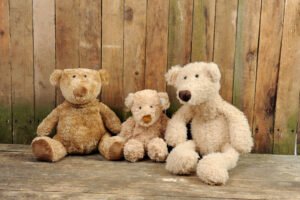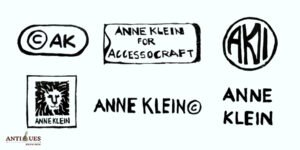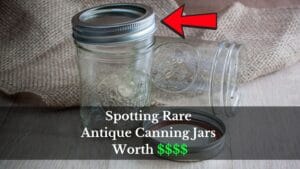Children love teddy bears, don’t they? Like, they always ask for more and throw the old ones in the junk. But hey! If you still have your grandma’s teddy, you are in luck! That’s because these old, vintage teddies might make you rich! The mohair and fur, it’s rare now!
Of course! You won’t get extra money just because it’s old and hand-stitched. So, you need to see if it has those ‘antique’ and ‘high-price’ features on your old teddy bears. Now, before you ask me more, just get a pen! I’ll help you identify antique teddy bears easily!
Key Takeaways
- Long teddy bears with curved ears, humped backs, pads, and pin joints are among of the most high-value and rare teddy bears.
- Look for old, slightly stiff teddies with simple wire joints and pointed snouts for high returns. You can also get rare WWI-era models to raise costs.
- Vintage teddy bears with golden mohair or animal leather sidings are rare and branded. So, look for more cues like logos, trademarks, or printed paw strips to raise the valuation by 2 – 3%.
- Go with goat hair teddies with stuffed kapok or wood-chip stuffing for an old make. Also, look for black or blue wood eyes and a hand-stitched nose.
Key Identification Features of an Antique Teddy Bear

You don’t need any expert for antique teddy bear identification. In fact, any model with splayed legs and embroidered labels might be vintage! Next, check its stuffing and fabric. If it’s wood wool or silk, it’s surely old and antique. Here, you can raise the cost by 2-3%.
But that’s not all! Here are some more features for better identification:
- Triangular, upright heads and larger, curved ears
- Threaded seams and light embroidery on the claws and toes
- A triangular muzzle and button or glass eyes
- Humped back and erect posture
- Padded feet and tapered arms
- Simple cardboard and metal pin joints with a woven finish
History & Evolution of Teddy Bear Toys
Morris and Rose Michtom made the first ‘Teddy’s bear’ to mark President Roosevelt’s (Teddy’s) bear hunt. It was a simple, stuffed toy with socked hands, feet, and button eyes. And it also had felt lips and a silky nose at the top.
Steiff, a German toy factory, manufactured the first commercial bears in 1903. These elongated, humpback models had tapered feet and chubby bodies. And they also had straight limbs, curved paws, and golden bands. So, they fetch good returns today.
However, in 1905, manufacturers started making portable teddies with thin straw stuffing. They even used felt, cotton, or velvet pads for the paws and etched a logo on top. And these branded bears are easier to track and yield higher prices at any auction.
4 Types of Antique Teddy Bears & Their Values
Vintage teddy bears use different stuffings, fabrics, and eyes that impact their cost. But they even have four main types that track their age and value.
1. American Teddy Bears (1906 – 1908)
If you see a tall teddy with light mohair, brown muzzled, and black seams, it must be an American one. You can also look for vertically stitched noses, amber eyes, and five-claw feet with them. Next, check their foot pads to value them correctly.
You’ll get them in two types:
- Cardboard Foot Pads: These cardboard foot teddies have a tied label and a ladder stitch at the legs. They are pretty vintage and have shoe button eyes, felt lips, and a silk nose, worth $120 – 150.
- Fabric Foot Pads: These are newer American teddies with cotton foot pads, pointed claws, and a rust-yarn nose. But since they are rare and less embroidered, they are valued at up to $500.
2. German Teddy Bears (1906 – 1907)
German teddy bears are short, plump bears with natural fiber mohair and fixed limbs. They have pointed ears and red, beige, or yellow ear tags with a logo and trademark. They usually have four claws and round, bulgy feet.
Old German teddies also had brass, nickel, or gold buttons plugged inside the left ear. So, these are worth around $500 – 700.
3. French Teddy Bears (1919 – 1920)
French teddies are luxurious cotton toys with coarse mohair and a softer stuffing. They are more flexible and have rotating hands and feet with five claws. They are also longer, huggable, and the first to use holed glass button eyes and whiskers.
French teddy bears are functional and have broader, rounded laps for easy holding. But since they are mass-produced and common, they fetch lower returns of around $100 – 150.
4. British Teddies (1920 – the 1940s)

You can identify British teddies with their silk mohair, round humps, and trimmed muzzles. Most will also have cupped ears and criss-cross nose stitches. Yes, these are new! But since they evolved during the Economic Depression, they are still rare and precious, up to $250.
9 Factors to Identify & Value Antique Teddy Bears
Old teddy bears are valuable and fetch $200 – $3,000 depending on their age, shape, brand, and stuffing. Generally, elongated, golden teddy bears are the most precious. But lightweight cotton teddies from the WWI era can also fetch good returns up to $500.
Antique teddy bears have distinct eyes and shape that age and help you spot them correctly. But there are many more factors that affect their authenticity and worth!
1. Teddy Bear’s Age
The worth of a teddy bear changes with age, but old teddies from the 1900s are the most precious. Their valuation goes higher if they have boot-button eyes and shiny silk sidings. Similarly, chunky cotton teddies from the WWI era are unique and valuable.
In contrast, factory-made foam teddies from the late 1950s are easy to get and cheaper, so you better stay away from them!
Here’s a checklist to track the teddy’s age:
1. Teddies from the Early 1900s: Look for golden teddies with flat limbs and triangle heads. They are about 19.5 inches tall and have pointy ears and black eyes.
However, most do not have a label. So, to spot them, look for cross stitches, felt lips, and rough wool stuffing. If you see some golden ear buttons or bands, you can easily price them for $1000 – $1500.
2. Teddies from the Early 1910s: These short, stout teddies have button eyes and round tummies. They are cotton-based but might have metal logos and labels, costing $700 – 800.
3. Teddies from the 1940s: These evolved during the Great Economic Depression. So they are lightweight and have cheaper kapok stuffing. Depending on the company, they might have a cotton or mohair lining, but they cost $600-1000.
4. Teddies from the Late 1950s: These new commercial teddies are seamless and cotton-made. These are easy to track and have unique product codes and logos on their feet and ribbons.
Here are some common product codes for quick reference:
| Year | Teddy Age | Product Code | Manufacturer | Valuation |
| 1914 | 108 | ISA – 107A | Chad Valley | $300 – 400 |
| 1931 | 91 | HYGA NA | Peacock Stores | $100 – 120 |
| 1926 | 96 | ALPHA | Farnell | $400 – 500 |
2. Body Structure & Shape
Olden teddies weren’t always long and thin. In fact, you get them in so many shapes – chubby, hump, or curved, some even with resin boots and seams. Of these, the ones with a triangle face are valuable teddy bears. While, the round, chubby ones are a bit cheaper.
Here’s how the value of antique teddy bears changes with the shape!
| Shape & Body Structure | Average Valuation |
| Elongated Body & Triangular Face | $500 – 600 |
| Short Body & Oval Face | $350 – 400 |
| Plump Body & Round Face | $30 – 50 |
| Round Face, Round Muzzle & Embroidered Smile | $60 – 70 |
| Thin Body, Nose & Lipless | $20 – 30 |
3. Fur Color

You might get many bold red or pink teddies now. But antique bears were mostly white, beige, or golden. But if you see some exclusive bold-colored patchwork, brown or blue mohair, you can raise the cost by 5-6%. And even neutral or buff teddies are a wise pick!
Want to know how each color impacts the teddy’s cost? Read on to know!
| Teddy Bear Color | Manufacturing Year | Age | Valuation |
| White, Beige, Buff, and Yellow, Cream | 1903 | 119 years | $70 – 80 |
| Black, Dark Brown or Fawn | 1910s | 112 years | $50 – 60 |
| Blue, Teal or Purple | 1910s (Limited Edition) | 112 years | $70 – 80 |
| Red, Green, Pink | 1912 and above | 110 years | $40 – 50 |
Wash the teddies to check their color, as soiled white ones can be mistaken for beige.
4. Branding
If you want durable and valuable teddy bears, why not go for the branded ones? In fact, any bear with a ‘Steiff,’ or ‘Novelty’ mark raises the value by 12 -13%. Plus, these are either Germany or Britain-made. So, you’ll also get the import scripts and trademarks with them!
Old teddy bears with stamped logos or product code value $200 – 300. But embroidered logos are more precious and might fetch $500 at the auction.
Here’s a list of some popular teddy companies for reference:
| Company Name | Year | Region | Top Features | Valuation |
| Steiff | 1902 | Germany | Gold ear buttons, light brown mohair, rounded face, and bulgy feet | $150 – 250 |
| Novelty & Toy | 1920 | America | Glass eyes, Triangular face and muzzle, Round ears | $100 – 120 |
| J.K Farnell | 1932 | England | Round heads, Felt feet, Golden mohair, and four claws | $200 – 250 |
| Aetna Toy Animal | 1919 | New York | Glass eyes, Felt lips, Upright posture, and Rounded Thighs | $180 – 200 |
| Knickerbocker | 1950s | America | Short arms, legs, Round muzzles, Upright ears, and Embroidered lips | $80 – 100 |
NEVER purchase softer cotton or polyester stuffed teddies as these might be first-edition or low-value models.
5. The Fur or Fabric
Old teddy bears with a golden Angora goat mohair are valuable. But, even sheep skin or artificial silk teddies from the 1920s are high-valued at $100 – 120. Similarly, brushed or textured cotton teddies from the WWI era are precious, valuing $70 – 80.
In contrast, synthetic felt teddies are quite new and have a lower valuation of $20 – 30.
Here’s a list of common old teddybear fabrics, their uses, and valuation:
| Fabric Name | Year | Valuation |
| Goat Fleece & Mohair | 1900s – 1950s | $150 – 200 |
| Artificial Silk Plush | 1920 – 1938 | $100 – 120 |
| Synthetic Plush | 1940s | $70 – 80 |
| Rexine oil cloth | 1960s | $20 – 30 |
Soak your teddies in hot water and wash them with baby shampoo to get rid of all the dirt, debris, and discoloration.
6. Stuffing
Old teddy bears have four types of stuffing – wood, kapok, cork, or plastic. Of these, the natural wood, chip, or kapok stuffing is old and values up to $200. In contrast, synthetic rubber, cork, or plastic is new and cheaper, costing up to $80.
7. Eye Shapes & Types
Teddies with wooden or leather-covered eyes are precious and can value up to $500. Similarly, even black, blue, or transparent glass eyes fetch good returns.
But modern plastic or screw-in eyes or rounder acrylic eyes are brittle and low-valued. And even chipped or discolored boot-button eyes have a lower valuation of $8 – 10.
Rub the teddy’s eyes with your fingers and spray some water to check the eye material. Old, glass eyes will become cooler, but newer acrylic eyes will still be hot.
8. Teddy’s Nose

Hand-stitched, black or brown embroidered noses are precious. But curled leather, plastic, or painted tin noses are cheaper and fetch $3 – 4 at a bid. In contrast, triangular noses with whiskers and broad, felt nostrils cost about $9 – 10.
Never use a blow dryer to dry rare teddy bears, as it might damage and shrink the fabric.
5 Rarest & Most Expensive Teddy Bears to Find!
Limited-edition, clothed, or leather-button teddy bears are valuable despite their age and condition. These teddies are bigger and might have royal origins. Plus, they have a lower circulation and a high demand that hikes their cost by 15 – 20%.
Here are some rare teddy bears to collect:
| Name | Manufacturer | Avg. Value | Circulation Number |
| Karl Lagerfeld Teddy Bear | Steiff | $3,687 | 2500 |
| Snuffles Teddy Bear | Gund | $10,000 | 1500 |
| Rod Bear PB28 | Steiff | $12,000 | 1200 |
| Diamond Eyes Bear | Steiff | $35,000 | 125 |
Look out for glass or jewel eyes and a felt mouth to identify rare, vintage teddies.
How Can You Tell a Vintage Teddy Bear?
You can identify a vintage teddy bear based on its hump, limb size, and overall thickness. Generally, old teddies are thin and have triangular faces with cupped ears. They are also more neutral-colored and have boot-button eyes.
Do Steiff Bears Increase Value?
Yes, Steiff Bears are around 10 – 12% more valuable than common tedd bears. Look for black or brown eyes, triangular muzzles, straight limbs, and claws to spot them!
Antique teddy bears are precious, despite their shape and condition. But you can pick golden, mohair bears with jewel-studded or glass eyes for a better valuation. Various other factors like fabrics and logos will help you identify the bear and track its age. But if you want to spot real Steiff bears, you may want to look for some other signs that I’ve explained in my guide!
Note: This article is intended for informational, educational, and entertainment purposes only. Some images are illustrative and may not represent actual brands, products, or related entities. All trademarks, product names, brand logos, packaging, and other intellectual property referenced remain the exclusive property of their respective owners. Any brand mentions or references are provided solely for descriptive and educational context and do not imply any formal or commercial association.










